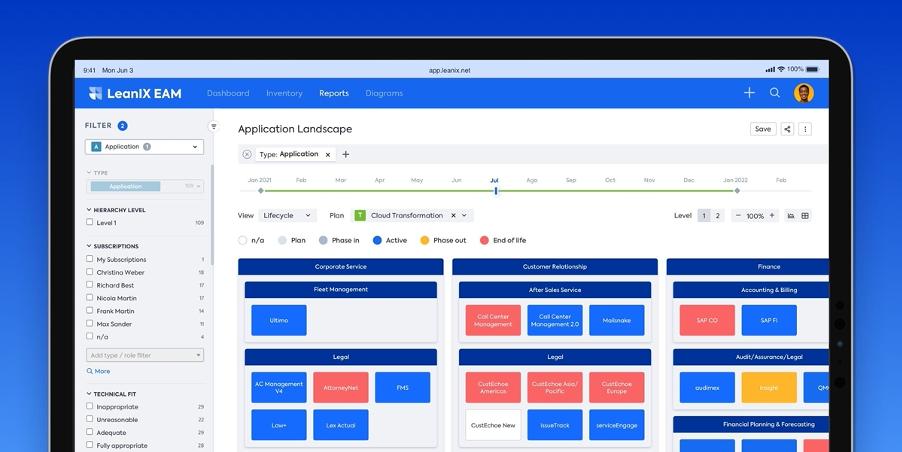
Solution architecture and enterprise architecture are two related disciplines that both require a thorough understanding of your IT landscape. Let's explore these two methodologies and how they can work together to drive positive change in your organization.
Solution architecture and enterprise architecture are often considered to be overlapping disciplines. Both involve connecting overarching business strategy, day-to-day operations, data management, and information technology (IT) to drive improvements in your IT landscape.
In this article, we'll explore the differences between the two disciplines, but also look at the similarities. The shared skills of research and planning are supported and enhanced by using the LeanIX EAM as a shared information repository.
To find out more, see our LeanIX EAM homepage:
LEANIX EAM: Manage The Transformation And Risk Of Your It Landscape
In the meantime, let's consider the difference between a solution architect and an enterprise architect, as well as how the LeanIX EAM can support both.
What Is Solution Architecture?
Solution architecture is a process whereby a solution architect works with the information technology (IT) teams in a business to create a viable technology solution to a specific problem. They will consider the scope, budget, requirements, and consequences of enacting the solution, as well as working on change management.
As opposed to enterprise architecture, solution architects focus their scope on a specific project to solve a single problem, and will expand their scope to consider any involved area of your business. This will include engaging with stakeholders outside of IT and working on technology, strategy, and operations, where required.
For example, a solution architect might be engaged when a regulator identifies a data privacy breach. The solution architect will then analyze the breach and propose the most viable solution, whatever that may be.
Solving the problem could involve:
- having your engineering team build a new application that is compliant
- re-engineering the current application to fix the problem
- arranging staff to be retrained to avoid human error
- organizing data migration to a new data center
- recommending a change of strategy to senior management
The solution architect could also enact a project that involved elements of all of the above, along with other initiatives. Essentially, solution architecture is about creating a solution to the problem using whatever discipline is required to do so.
This makes a solution architect both a detective and an engineer. They must investigate an often ill-defined problem and then imagine a practical solution.
Doing so effectively involves both a strategic, high-level understanding of the moving parts of your organization, as well as technical know-how regarding the potential capabilities of IT tools. It's a complex discipline that requires expertise and creativity, and can have a tremendous impact on your organization's success.
What Is Enterprise Architecture?
Enterprise architecture is a strategic framework that aligns an organization's business strategy, processes, information, and technology to achieve its goals. An enterprise architect will take a high-level look at your entire organization and continually work to optimize all processes to give the best chance of success.
As opposed to solution architecture, enterprise architects look at the whole organization, rather than just what's necessary to solve a specific problem. Instead of just chasing a solution, enterprise architects are in constant contact with your entire organization as they foster a culture of continuous transformation and improvement across your entire landscape.
For example, an enterprise architect may work to conduct regular application rationalization initiatives. This will involve assessing all of the software applications in use across your organization to determine if:
- certain applications are no longer needed
- some applications can better support your organization with more investment
- duplicate licenses and instances can be merged
To find out more about the value of application rationalization, download our free guide:
EXPERT GUIDE: Applying The Gartner TIME Framework For Application Rationalization
Other initiatives an enterprise architect could manage include:
- Enterprise resource planning (ERP) transformation
- Application modernization
- Obsolescence risk management
- Post-merger IT integration
- SaaS contact management
- Value stream management
The key difference between solution architecture and enterprise architecture is that solution architects are focused on dealing with one specific problem at a time, while enterprise architects continually assess and optimize your entire IT landscape.
Solution Architecture Vs Enterprise Architecture
If a solution architect is the freelance private detective hired to crack a single case, then the enterprise architect is the chief of police looking at long-term ways to reduce the overall crime rate across the city. While solution architecture is focused on the specific practicality and fine details of a defined initiative, enterprise architecture looks at the big picture for your organization.
There are merits and blind spots for each discipline, so it's best to leverage both methodologies in support of your business strategy. While your enterprise architects will focus on continuous optimization of your IT landscape and the bigger picture, your solution architects will be the trouble shooters who are called upon to fight fires when they arise.
To really empower both disciplines, however, the key is documentation. With a single, shared source of truth to record all the results of their investigations, comprehensive information is available to both parties at any time.
Utilizing an information repository, time and effort are reduced for both solution architects and enterprise architects, allowing them to be more effective. In addition, this shared source of truth offers collaboration opportunities for each team.
This is why both solution architects and enterprise architects can benefit from LeanIX EAM.
LeanIX EAM For Solution Architecture

Whether solution architects are investigating a single problem and roadmapping a solution, or enterprise architects are assessing your IT landscape for optimization opportunities, LeanIX EAM has the answers they need.
Leverage our EAM to gain real-time overviews of your IT landscape and business capabilities, then visualize a consistent overview of your application landscape and its respective components. Using this viewpoint, solution architects and enterprise architects can connect the dots to identify opportunities to solve specific problems and sustain continuous transformation journeys.
Don't take our word for it, however. Use our LeanIX EAM ROI calculator to determine, in advance, the cash value of investing in our EAM:

/EN/White-Paper/EN-IDC-Inforbrief-Application-Rationalization-Portfolio-Management-Thumbnail_v2.png?width=140&height=99&name=EN-IDC-Inforbrief-Application-Rationalization-Portfolio-Management-Thumbnail_v2.png)

